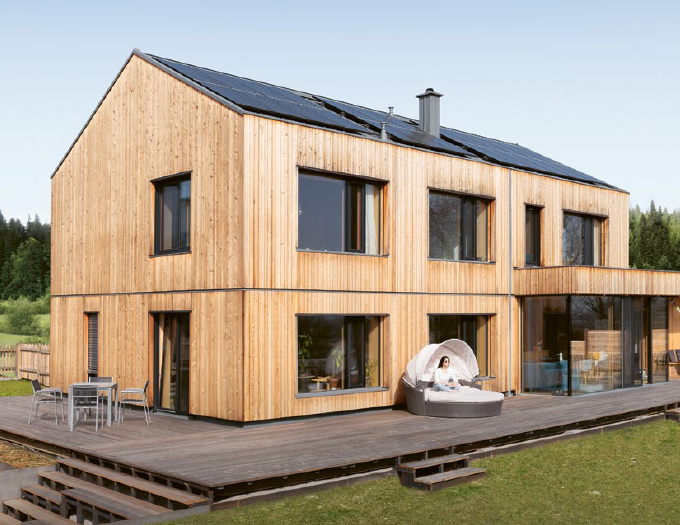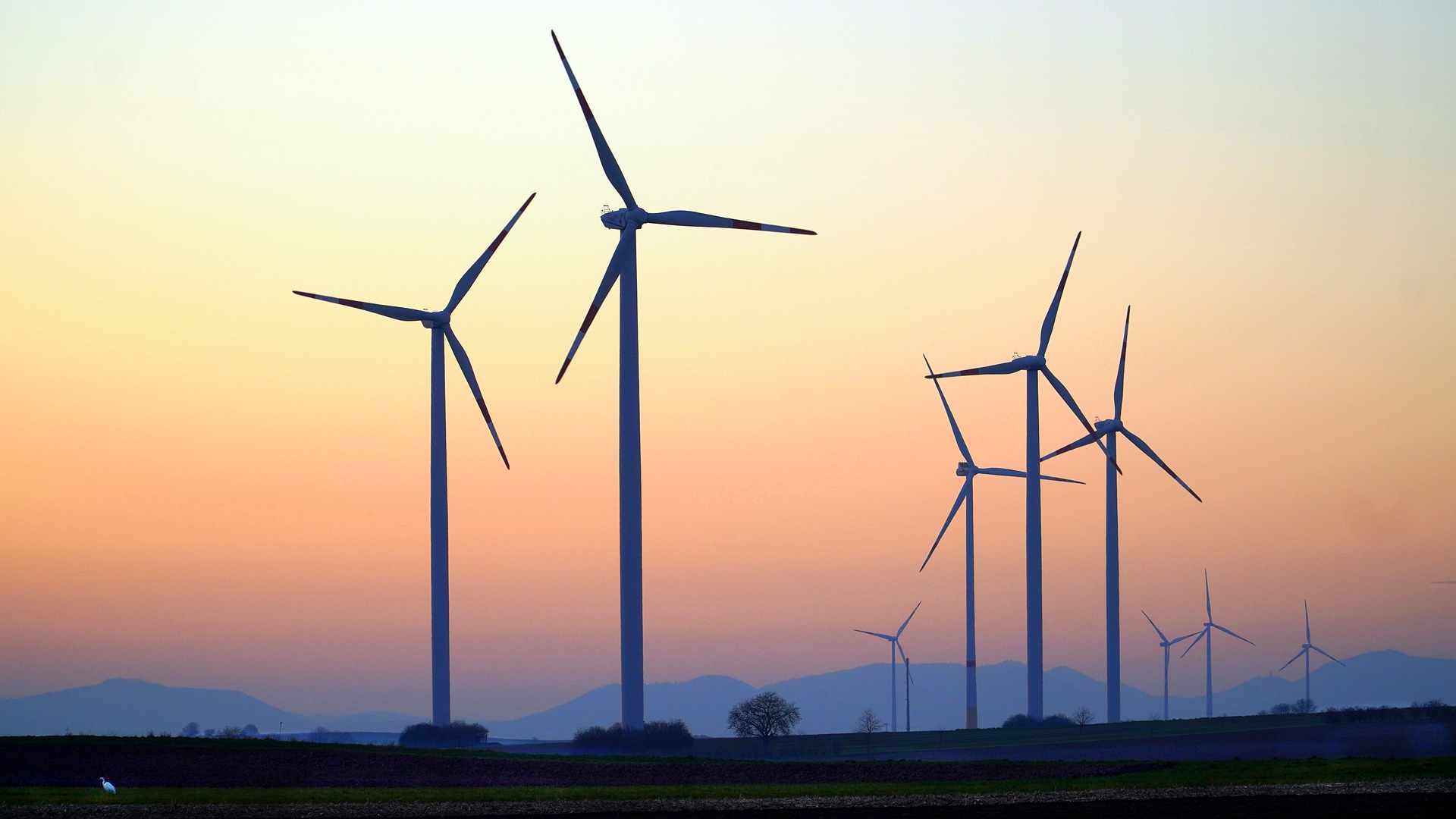Green energy explained - how to choose the one that's right for you and your home
Green energy is a growing concern, and our expert guide will show which type is right for the way you live


Green energy is a hot topic. In the wake of all the international goal setting, most of us have a general idea what green energy is but with deadlines looming for us to be net zero. Yet we need more clarity and to know what is available to us and - more importantly - which sustainable source will save us money. So what are the options, which one is best for you, and which is the most achievable?
In a typical household, over half the fuel bill is spent on heating and hot water.
To reduce bills as well as reducing carbon emissions, you need to make sure your home has an efficient heating system that you can control easily. If we are to reach the net zero target, we will need to reduce the carbon emissions from heating our home by a huge 95% by 2050, mainly by reducing carbon dioxide. There will be significant changes ahead in how we heat our homes, but in the meantime there are ways we can save money on fuel bills and at the same time reduce our carbon emissions.
For many years we’ve used natural gas to heat our homes - currently 85% of householders, and 40% of electricity also relies on gas, which comes from oil and gas fields. Methane is the main constituent of ‘natural gas’. We’ve continued to use natural gas because it’s a readily available resource, its cost-effective and it’s a cleaner alternative to coal – the dirtiest fossil fuel we have, and what we used before.
When natural gas is burnt, it provides heat energy. But a waste product, alongside water, is carbon dioxide, which when released into the atmosphere contributes to climate change. ‘So, we have to find new and cleaner ways to heat our homes,’ says John Cook of National Grid ESO. 'Electricity is becoming increasingly low carbon, as more renewable sources are connected to the electricity grid, slowly replacing existing gas and coal power stations. We consider the key generation types in terms of zero carbon – nuclear, wind, hydro and solar, and fossil fuels – gas and coal.’
Green energy suppliers are becoming more commonplace, but to reach net zero heating by 2050, the Energy Saving Trust believes that air source heat pumps will lead the way.
Green energy - the options explained
WIND POWER

We have been taking advantage of the wind for power for thousands of years - sailing vessels to carry cargo to trade and windmills to mill grain for food. Today the major use of wind power is to generate electricity using wind turbines. The turbine consists of a generator in a ‘nacelle’ at the top of a high tower, the wind turns the blades of the turbine, and these in turn spin the generator. It is a popular, sustainable, renewable energy source that has a much smaller impact on the environment than burning fossil fuels. The energy is passed through a transformer that increases the voltage and then goes into the National Grid.
The Livingetc newsletters are your inside source for what’s shaping interiors now - and what’s next. Discover trend forecasts, smart style ideas, and curated shopping inspiration that brings design to life. Subscribe today and stay ahead of the curve.
What are the advantages of wind power?
The advantages of wind power are:
1. It’s a renewable source – as long as there is wind to turn the turbines there will be power.
2. It’s cheap to run
3. Wind power is safe
4. It has zero emissions and is a clean fuel source
5. It has one of the lowest water-consumption footprints
6. It creates wealth and jobs
What are the disadvantages of wind power?
The disadvantages of wind power are:
1. There is a high cost of manufacture and in installing wind turbines.
2. Turbines take up land from agriculture and livestock
3. There can be a visual impact on the landscape
4. It can be intermittent depending on the strength of the wind
5. Wind turbines can be noisy
6. They can be a hazard to shipping at sea
7. They can cause bird deaths
Possible annual energy cost savings from using wind power
A well-sited 5KW turbine can generate around 7,500KWH a year which could save you around $500/£340 a year on your electricity bills. The renewable energy generated could also save around 1.9 tonnes of carbon dioxide a year.
GEO THERMAL POWER

Geothermal energy is energy generated and stored in the earth. To produce power from geothermal energy, wells are dug a mile deep into underground reservoirs to access the steam and hot water there, which can be used to drive turbines connected to electricity generators. There are three types of geothermal power plants – dry steam, flash and binary.
Dry steam is the oldest form of geothermal technology and takes steam out of the ground and uses it to drive a turbine.
Flash plants turn high pressure hot water into cool, low-pressure water.
Binary plants pass hot water through a secondary liquid with a lower boiling point, which turns to vapour to drive the turbine.
On a domestic level, this type of energy relates to ground source heat pumps which use pipes that are buried in the garden to extract heat from the ground. It circulates a mixture of water and antifreeze around a loop of pipe, called a ground loop, which is buried in your garden. It is usually a horizontal system, but there are vertical systems available. It does use electricity to do this, but the heat energy delivered to your home is more than the electrical energy used to power the system. This makes a heat pump an extremely low carbon heating option, increasingly so as our electricity grid further carbonises. This heat can then be used to heat radiators, underfloor heating or warm air heating systems and hot water in your home.
What are the advantages of geothermal energy?
The advantages of geothermal energy are:
1. It is renewable and sustainable.
2. It is carbon-free.
3. It provides a continuous, uninterrupted supply of heat and is unaffected by seasonal changes.
4. It will heat your home as well as your water.
5. There is minimal maintenance required.
6. It can reduce your heating bills.
7. Unlike gas or oil boilers, heat pumps deliver heat at lower temperatures over much long periods.
8. It could lower your home carbon emissions depending on which fuel you are replacing.
What are the disadvantages of geothermal energy?
The disadvantages of geothermal energy are:
1. There is a high build cost.
2. Your garden needs to be big enough and the ground suitable for a trench to be dug, or a borehole for a vertical system, and you will need access to the garden for digging machinery.
3. In winter, it may need to be on constantly to heat your home efficiently, but radiators won’t feel as hot to the touch as with other types of heating like a gas or oil boiler system.
4. You may need to add extra insulation and draught-proofing in your home for it to be effective.
Solar power

Solar power works by converting energy from the sun into power. There are two forms of energy generated from the sun for our use – electricity and heat. Both are generated through the use of solar panels, which range in size from residential rooftops to ‘solar farms’ stretching over acres of rural land.
There are two main types of solar panel. Photovoltaic (PV) is used for converting sunlight into electricity, and solar thermal panels generate heat.
Solar PV panels are made from silicon installed in a metal panel frame with a glass casing. Light hits the panel and creates an electric current which is captured by the wiring in the solar panels. The DC electricity is then converted to alternating current (AC) electricity by an inverter. AC is the type of electrical current used when you plug appliances into normal wall sockets.
Solar thermal panels are less sophisticated and have been around for longer. They work by the direct heating of water (or other fluids) by sunlight. For domestic use, solar thermal panels are installed on a roof facing the sun, the water or fluid in the panels is heated, then is pumped to a heat exchanger inside a hot water cylinder in the home before flowing back to the panels for reheating. This then provides hot water and heating in the home and usually works in conjunction with a gas or fuel central heating system that starts working when the temperature in the water tank falls below a certain temperature. These systems can provide hot water all year round, even in cool climates.
A grid-connected system means any excess electricity you create at home can be fed into the National Grid through an inverter and you receive payment for this. Conversely, should you need more electricity than your solar panels have generated, the grid can supply this for a charge. Stand-alone systems are not connected to the grid but instead charge a solar battery. These batteries store the electricity generated by your panels for your own use for lighting, heating and water heating. This system is typically more expensive than grid-connected systems because solar batteries are still quite costly.
Solar power is a fast-moving industry. Increasingly PV panels are used as building materials and integrated into the roof or as facades. In some cases panels completely replace roof tiles. In others, alternative mounting solutions are used, with panels inlaid into aluminium trays. These are easy to install and a single panel can be replaced if necessary, without affecting the entire roof. The streamlined designs can make for quite stunning visual effects.
‘We are now producing panels which are like a glass ‘sandwich’ with the solar cells laminated between two pieces of super-strong glass,' says Pol Spronck of Solarwatt. 'They’re designed to last for up to 50 years, rather than the usual 15 to 20, which is obviously better for the planet as they last longer and don’t need replacing so often.’
All of which goes a long way in helping in our quest towards sustainable living.
What are the advantages of solar power?
The advantages of solar power are:
1. Solar energy is renewable, it is free and doesn’t damage the environment.
2. It is limitless as long as the sun keeps shining.
3. It is emission-free.
4. It has low operating costs
5. It is a clean source of electricity
6. It is flexible – it can be deployed on an industrial scale or it can power a single household
7. The carbon footprint of solar panels is small, as they last for between 20 - 50 years with no loss in efficiency. The materials used in the panels are increasingly recycled, so the carbon footprint will continue to shrink.
8. You may have reduced electricity bills.
9. You can receive payment from the government by giving excess energy back to the National Grid.
What are the disadvantages of solar power?
The disadvantages of solar power are:
1. It has a high initial cost.
2. It can be an intermittent energy source.
3. Solar panel farms take up a lot of space and have a visual impact on the landscape
4. There is a small amount of pollution during manufacture, transportation and installation.
5. They are not ideal if you are thinking of moving house.
6. Installing solar panels on your roof means you can't have a green roof, which aids biodiversity.
BIOFUEL
Biogas and biomass are both biofuels which can be burnt to produce energy. Biomass is a solid, organic material and has been used as an energy source since humans first discovered fire and burnt wood, plants and animal manure to create energy. Biogas is a renewable fuel produced by the breakdown of organic matter such as food scraps, animal waste, municipal rubbish, plant material and sewage.
Biogas is also known as marsh gas, sewer gas, compost gas and swamp gas. Put simply, biomass is the raw material and biogas is the end product.
The organic matter is broken down by micro-organisms in a process called anaerobic digestion. For this to take place, the waste material needs to be enclosed in an environment where there is no oxygen. It can occur naturally or as part of an industrial process to intentionally create biogas as a fuel. Biogas consists mainly of methane and carbon dioxide. It can also contain small amounts of hydrogen sulphide, siloxanes and some moisture, depending on the type of waste being used. It can be used in a variety of ways including vehicle fuel and as a replacement for natural gas. If biogas is cleaned up and upgraded to natural gas standards, it is then known as biomethane and can be used in a similar way to methane, including heating and cooking.
Today many power stations run by burning a biomass of compressed wood pellets – a by-product of timber and furniture-making. This enables renewable electricity to be produced which is greener.
In the UK there are 118 biogas plants in operation, while the US has over 2,200 sites in 50 states producing biogas.
What are the advantages of biogas?
The advantages of biogas are:
1. It is a naturally-occurring and renewable source of energy.
2. It is sustainable and biodegradable.
3. There is no contamination of soil or underground water.
4. It has low carbon emissions.
5. Studies show that greenhouse gases are reduced by up to 65%.
What are the disadvantages of biogas?
The disadvantages of biogas are:
1. There is a high cost of production currently.
2. It can take up large tracts of land to produce the crops.
3. Large amounts of water are needed for the crops.
4. It Is labour intensive.
5. Cars have to be modified to use bioethanol
Hydrogen
Hydrogen is a clean alternative to methane, also known as natural gas. It is the most abundant chemical element, estimated to contribute 75% of the mass of the universe. Hydrogen can be produced from a variety of resources, such as natural gas, nuclear power, biogas and renewable power like solar or wind. The challenge is harnessing hydrogen as a gas on a scale to fuel our homes and businesses. The good news is that hydrogen can be transported through gas pipelines, minimising disruption and reducing the amount of expensive infrastructure needed to build a new hydrogen transmission network. There would also be no need for a culture change in our home lives as people are used to using natural gas for cooking and heating, and hydrogen equivalents are emerging.
There are also cars that run on hydrogen fuel cells. Japan, Germany and the US are leading the way with public hydrogen refuelling stations.
The National Grid is committed to preparing to change our gas usage over the years between now and 2050 and one of the ways of doing this is through hydrogen
What are the advantages of Hydrogen fuel?
The advantages of hydrogen fuel are:
1. When hydrogen is burnt the only waste product is water vapour.
2. There are no emissions.
3. It could add value to houses in areas less suited to electrification.
What are the disadvantages of hydrogen fuel?
The disadvantages of hydrogen fuel are:
1. There is, as yet, no blueprint for a conversion of a gas grid to hydrogen anywhere in the world.
2. Producing hydrogen at a scale required to decarbonise heating will not be easy.
3. It is expensive to produce
4. Most of the hydrogen produced right now is not low carbon
HYDROPOWER
Hydropower, or hydroelectric power, or water power, is one of the largest sources of renewable energy. Water is held behind a dam in a lake or reservoir at a high level. Rivers or rainfall fill the reservoir then when the energy is needed, the water is allowed to run down through pipes to another lake lower down. As the water runs through the pipes, it spins turbines that are linked to generators to produce power. The water is pumped back up during the night when electricity is cheaper. Hydroelectric power stations are used to provide additional electricity to the National Grid at peak times of the day.
What are the advantages of hydropower?
The advantages of hydropower are:
1. It's clean and renewable – it will never run out as long as water keeps flowing.
2. It is affordable, providing low-cost electricity and durability over time compared to other types of energy.
3. It is a clean and non-polluting source of energy.
4. It is reliable and adjustable -the plant can produce more energy when it is required or reduce the energy when it is not needed.
5. No fuel is required, water is the source of energy and it does not consume water.
6. It provides flood control and irrigation support.
7. It is emission-free – it does not produce greenhouse gases.
8. It creates lakes and reservoirs which are beautiful, attract wildlife and create leisure opportunities which could help the local economy.
9. It complements other renewable energy sources – pumped storage hydropower can be used in tandem with wind and solar power when demand is high.
What are the disadvantages of hydropower?
The disadvantages of hydropower are:
1. It has an environmental impact and can displace people.
2. Plants are expensive to build and there are limited locations which means that the plants are not always near to major cities that could benefit from the energy.
3. There is the potential for droughts affecting energy production. As climate change continues to warm up the planet, this will become more common.
4. There are limited reserves.
5. It has an impact on fish travelling to breeding grounds, as a running water source must be dammed.
6. There is a flood risk – when dams are built at higher elevations, they pose a risk to any town that is below it.
7. Trapped and rotting vegetation can produce greenhouse gases such as methane.
Easy green energy changes to make right now

1. GET A SMART THERMOSTAT
Your thermostat controls 60% of your energy consumption. So if you are not planning to switch your heating system yet, installing a Smart learning thermostat such as Nest or Hive will help to save you money. Part of a fully automated home, it learns what temperature you like when you are home, or not, throughout the day, raising it while you’re in and lowering it when you are out, or overnight. It learns how your home warms up or how draughty it is, so it only uses the energy it needs, saving you energy and money. It also tells how you can further save money, and you can override it if your habits change. They are primarily used to control gas central heating systems, however, in the UK and Europe (not the US unfortunately) the Nest Learning Thermostat ships with a Heat Link Relay, which is controlled wirelessly by the Nest Thermostat to toggle your boiler’s heating on and off. With this device, it’s possible to get your Nest to control an electric heating system too.
2. UPGRADE YOUR INSULATION
One of the other things you can do now is to make sure your home is properly insulated. It’s one of the eco-friendly ways to save energy that isn’t too expensive to do and will definitely make your home warmer. A well-insulated house will have better all-round energy efficiency and minimise heat loss. You can even have eco-friendly insulation installed if you want to be even greener.
3. REPLACE YOUR WINDOWS
Double-glazing is another effective home improvement that will boost your home’s energy efficiency. Upgrading from single glazing to double-glazing will reduce your energy costs and keep your home well insulated. It’s also important to replace double glazing to ensure it’s effective – on average most double-glazing needs replacing every 20-30 years.
4. ENERGY-EFFICIENT LIGHTING
An easy, eco-friendly upgrade is to swap to energy-efficient light bulbs. They’ve been around for years, but the quality of the bulbs has noticeably improved, they last a lot longer and have come down in price in recent years, so its an easy win. You can even connect them to a smart home system so they’re even easier to use.
Amazon has a good selection of energy saving lightbulbs here.

Alison Davidson is well-respected British interiors journalist, who has been the Homes Editor of Woman and Home magazine, and the Interiors Editor for House Beautiful. She regularly contributes to Livingetc, and many other titles, and often writes about kitchens, extensions, and decor ideas. She is the go-to for information about green energy, sustainable home improvement and eco design ideas.